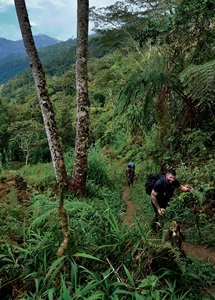For Energetics Engineer Heather — test day — is more exciting than most.
Fifty Years at the Rocket Ranch

By Boyd Udy
What do you call yourself when you’ve always been able to work at what you enjoy most? I call myself the luckiest man alive.
In 1970, I started working at a company that was then called Thiokol — making $2.45 an hour, by the way. This was just four years before we won the contract to build the rocket motors for NASA’s Space Shuttle Program. Fifty years later and I’m still here (Thiokol eventually became part of Northrop Grumman).
In that time, I’ve held a number of different positions, including in our labs for insulation design. That’s where I was working during the space shuttle Challenger accident, and I was able to assist with the return to flight by helping with the insulation portion of our rocket motor redesign. In 1989, I was hired to run the Promontory Ranch, and that’s what I’ve been doing ever since.
Life on the Rocket Ranch
The ranch spans about 6,000 acres and houses several water tanks and a couple dozen flowing wells that serve as the main water system feeding the entire Promontory plant — the same plant where we manufacture the rocket motors for NASA’s Space Launch System as well as the Common Boost Segment motors for our OmegA rocket. I maintain the entire ranch property, from general oversight to upkeep and preservation.
The most important part of my job is to monitor the water, making sure nothing and nobody bothers it. Without water, we wouldn’t be able to do the work we do. The mountain the ranch sits on provides the majority of the water needed to run the plant — keeping things cool, providing water for the restrooms and more. If the water were to become contaminated, we’d have a significant challenge keeping things going; the ranch provides roughly a half a million gallons of water a day to the Promontory plant.
It’s also important to maintain the ranch so it looks good and operates smoothly. I work closely with neighboring ranchers to ensure we have good relationships with our neighbors, and I oversee cattle operations for the people who lease the ground. Having strong relationships is very important to the plant.
I’m very proud that I’ve been totally trusted to run the ranch — I have full responsibility to do whatever is needed to keep things operating. I’ve been overseer of the property now for over 30 years, and did so while raising my three kids here. I will tell you, they all learned how to work, thanks to the ranch.
50 Years Behind the Scenes
Supporting Northrop Grumman and our programs from behind the scenes has been my life’s work. I have had great leadership throughout my career who have always empowered me to do my work and respected my perspective. When the company was deciding what the many uses of the ranch land would be, I was asked my opinion about leasing the ground for cattle grazing. It meant a lot to me that my opinion was so valued.
I’ve had the best bosses you could ask for. A memory that really sticks out for me is when I had a problem with my heart, in September 1999 — Bob Crippen, the former president of Thiokol, came out to the ranch to make sure I was okay. That meant so much. He was the pilot on the very first space shuttle mission, but he still took time to check on me.
People ask me if I have plans to retire. My answer? No, not really. The day I wake up and feel like I can’t do my job is the day I’ll decide to retire. This is more than a job for me — it’s my home and it’s my passion. Like I said, I am the luckiest man alive.
Explore our Careers page to learn more about how to help us define possible, and check out what life’s like at Northrop Grumman.
Life at Northrop Grumman
Your work at Northrop Grumman makes a difference. Whether you want to design next-generation aircraft, harness digital technologies or build spacecraft that will return humanity to the moon, you’ll contribute to technology that’s transforming the world. Check out our career opportunities to see how you can help define possible.


